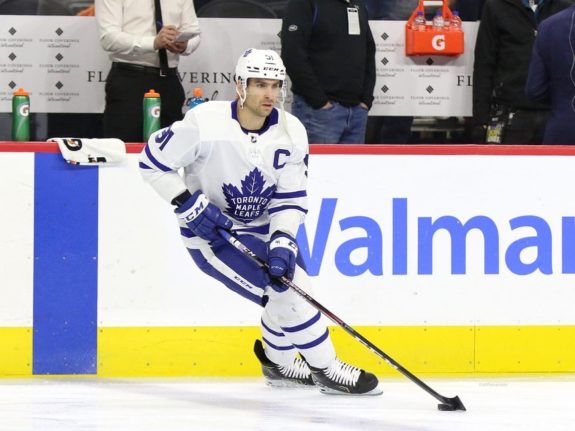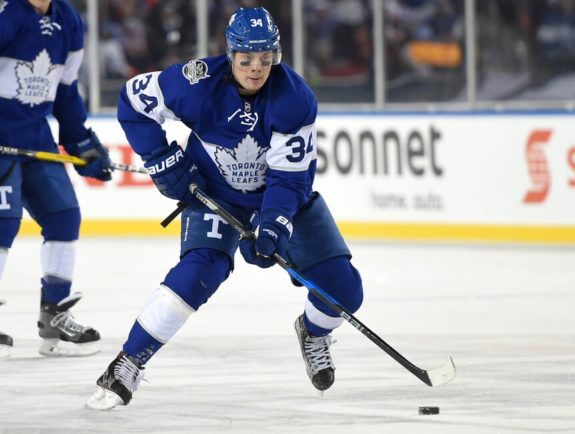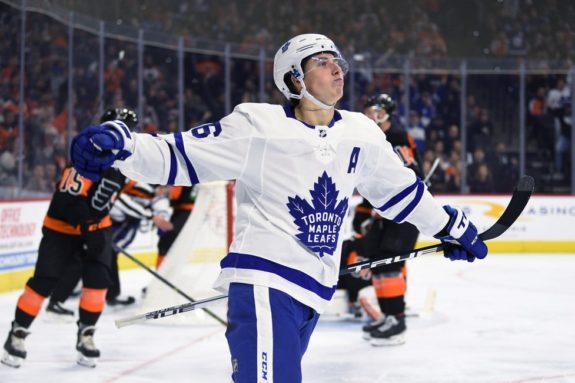The Toronto Maple Leafs’ “big four” (referring to Auston Matthews, John Tavares, Mitch Marner, and William Nylander) contracts take up $40.5 million in cap space. This accounts for just under 50% of the entire salary cap – the highest of any team in the NHL. Maybe more astonishing, the Leafs hold three of the seven largest contracts (by average annual value) in the league.
While you may not need a reminder, the big four contracts are:
| AAV ($M) / Term | Cap Hit % at Signing | Final Season | |
| Matthews | 11.634 / 5 | 14.63 | 2023-24 |
| Tavares | 11.0 / 7 | 13.84 | 2024-25 |
| Marner | 10.893 / 6 | 13.37 | 2024-25 |
| Nylander | 6.962 / 6 | 8.76 | 2023-24 |
The recent success of less top-heavy teams such as the 2017-18 Vegas Golden Knights and the 2018-19 St. Louis Blues has painted the picture that a more spread-out usage of the cap, focusing more on depth, may be a key for success.
Regardless of how you feel about such a top-heavy approach to cap management, or the individual signings themselves, pen has been put to paper, and the Leafs will have the $40.5 million cap hit on the books until the end of the 2023-24 season – when both Matthews and Nylander will become free agents.
Evaluating the Big Four’s Performance
With the year now past the halfway point, let’s examine how the Leafs’ big four players have performed to this point.
| Goals/GP | Points/GP | Points/60 minutes* | Corsi For %* | Expected Goals For %* | |
| Matthews | 0.66 | 1.18 | 2.88 | 55.1 | 52.0 |
| Tavares | 0.43 | 0.97 | 2.45 | 54.6 | 50.9 |
| Marner | 0.33 | 1.24 | 2.97 | 53.9 | 53.9 |
| Nylander | 0.43 | 0.86 | 2.53 | 55.3 | 50.8 |
*Assessed at even-strength, including 3-on-3 and 4-on-4 ice time
Looking at the numbers, every member of the big four has performed at a high level. Each player has a positive expected goal and shot attempt share, and is scoring at high rates. Still, with big contracts come big expectations: are the Leafs’ big four doing enough when measured against their contract comparables?
John Tavares: Performing as Expected
While he has slowed down compared last year’s career-high goals and points season, Tavares continues to perform, sitting one point under the elusive point-per-game mark.

As an unrestricted free agent (UFA) at the time of signing, Tavares’ contract has to be assessed differently from the other big four, who all signed as registered free agents. Tavares signing for 13.84% of the salary cap is similar to other UFA signings of the past five years, like Artemi Panarin (14.29%), Anze Kopitar (14.01%), Tyler Seguin (12.39%), and Steven Stamkos (11.64%), who all signed for seven or eight years.
Compared to these players, Tavares is performing well this year. He sits first among the group in Corsi For percentage (CF%), second in even-strength goals per 60 (behind Panarin), and third in even-strength points per 60 (behind Stamkos and Panarin).
Tavares, after the first year of his contract, was named the top UFA signing of the year by Sportsnet. Now on year two of his seven-year contract, he continues to perform at the level you’d expect from a UFA signing of his calibre. The big question will continue to be how the contract looks in its final years, as it’s not uncommon for UFA signings to start strong and quickly degrade towards the end.
Matthews: Elite Goal Scoring at a Cost
Matthews’ 0.66 goals per game (on pace for 54 goals this season) are simply exceptional. Matthews is second to only the Boston Bruins’ David Pastrnak for goal rate (on both a per-game and per 60-minute basis). At the end of the day, scoring goals is maybe the most valuable attribute a player can have, and Matthews is unarguably elite in that regard.

However, Matthews gets noticeably generous zone starts, beginning his shifts in the offensive zone over 73% of the time (including “on the fly” shifts. Matthews’ contract comparables also make it difficult to consider if his performance is living up to his contract. Signing at 14.63% of the cap, the recent restricted free agent (RFA) center signings Matthews compares to really only include Connor McDavid (16.67%) and Jack Eichel (13.3%) – both players have more points this season (on both a per-game and per 60-minute basis).
With Matthews’ contract being only five years (compared to eight for McDavid and Eichel), it may always be a difficult contract to stomach – even with how well Matthews has been performing. Five-year contract comparables are difficult to find, however, one notable signing comes to mind – Stamkos.
Following his entry-level contract, Stamkos signed for five years at 11.66% of the salary cap. The season after signing, Stamkos scored 60 goals, the highest-scoring performance of the decade, and he was recently named one of the top five centers of the decade. With Matthews’ contract being a full 3% of the salary cap higher, it’s still difficult to say if his elite goal-scoring is enough to warrant such a high cost and short term contract.
Mitchell Marner: Impressive Performance but at Unprecedented Price
Marner is a scoring machine, and looks better than ever with the increased ice time new head coach Sheldon Keefe has given him. Marner leads the big four in points per game played and expected even-strength goal share.
When considering value, Marner falls into the same trap as Matthews. While he’s incredibly good – is he worth the almost $11 million in cap hit? His $10.893 million AAV is the highest an RFA winger has signed for – ever. His contract, coming in at 13.37% of the salary cap, is so large it doesn’t really have close comparables. The closest, Mikko Rantanen (who signed at 11.35%), and Nikita Kucherov (who signed at 11.95% – for two extra years) are both still looking like better value even with Marner’s recent performance. Among these three players, Marner ranks second in CF% (behind Kucherov), third in even-strength goals/60, and second in even-strength points/60 (behind Rantanen) this season.

Marner’s performance so far this year deserves a ton of praise. His contract required him to take his performance to another level, and he has delivered – he’s on pace for 101 points over a full 82-game season despite a slow start.
Still, when his direct contract comparables include last year’s Art Ross and Ted Lindsay winner, Nikita Kucherov, Marner may need to continue elevating his game if he is going to live up to the price tag.
William Nylander: Recent Performance Starting to Make Contract Look Valuable
While Nylander’s contract, which included a holdout that caused him to miss three months of last season, was heavily scrutinized – it now has a valid argument for being the best forward contract on the Leafs. Nylander has exploded this year, playing at almost a point per game pace, and holding the best CF% of any of the big four at even strength this year.

Signing as an RFA winger for six years at 8.76% of the salary cap, Nylander’s closest comparables include Johnny Gaudreau (9.25%), David Pastrnak (8.89%), Kyle Connor (8.76%), Clayton Keller (8.76%), Nikolaj Ehlers (8%), Filip Forsberg (8.22%), and Brandon Saad (8.22%). Among these eight players, Nylander ranks second in CF% (behind only Forsberg), second in even-strength goals/60 (behind only Pastrnak), and third in even-strength points/60 (behind only Ehlers and Pastrnak) this season. Nylander’s contract looks good among his comparables, especially when considering Pastrnak’s contract is arguably one of the best in the league.
If Nylander, now playing alongside Tavares, can continue to elevate his performance, he may quickly become the Leafs’ best-value contract at slightly under $7 million.
Big Four Contracts: Still Too Early to Fully Assess
With each contract less than two years old, it is too early to make bold claims about the quality of the signings. So far this year, however, we can judge that Tavares and Nylander have performed at, or slightly above, the level that you would expect when considering their contracts. Marner and Matthews, while both playing exceptional hockey, appear to be performing roughly below the level of their contract comparables.
With all four contracts, time will likely determine how they are viewed. If the Leafs are able to win a championship during the big four’s window, it’s unlikely that anyone will be scrutinizing the AAV of any individual player.